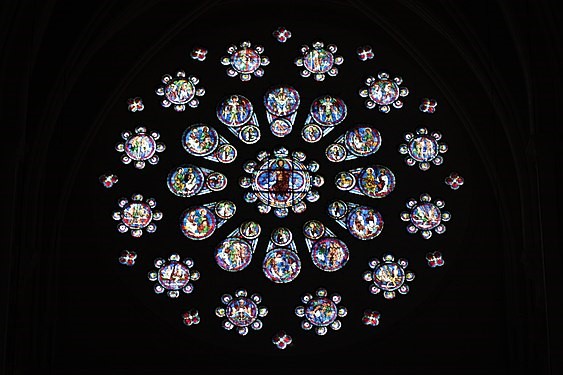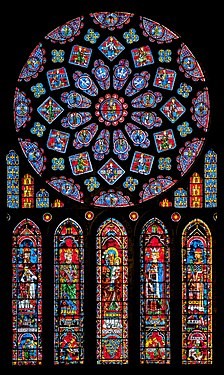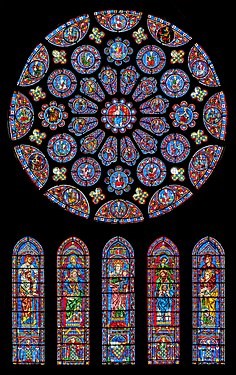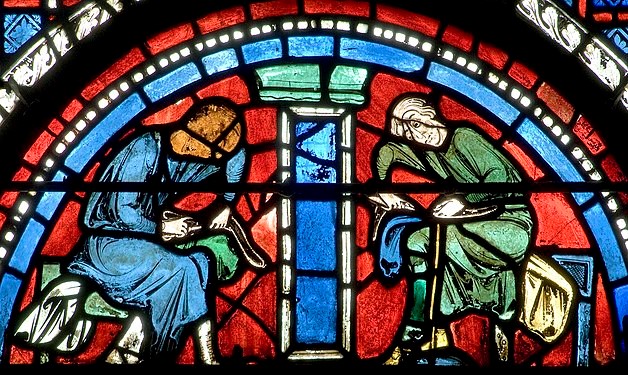Stained glass windows
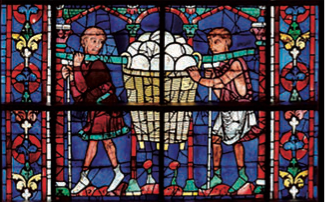
Chartres Cathedral stained-glass windows
The stained glass windows of Chartres Cathedral are a highlight ! They are renowned for their quantity and exceptional quality:
Diversity and Extent: According to Delaporte, the cathedral houses 175 stained glass windows, a significant number by any standard. This collection includes a variety of styles: large rose windows that provide focal points, smaller round oculi offering unique perspectives, and tall, slender lancet windows that add to the cathedral’s verticality and elegance.
Architectural Innovation: The cathedral’s advanced architectural techniques, particularly the use of rib vaults and flying buttresses, allow for taller, thinner walls. This structural innovation is especially evident in the clerestory, the upper part of the nave, choir, and transepts, which are adorned with expansive windows. This design maximizes the amount of light entering the space and enhances the windows’ visual impact.
Color and Lighting Effects: Chartres Cathedral’s stained glass windows are notable for their intense colors and intricate designs. Unlike later Gothic cathedrals, which often used more plain or grisaille (monochrome) glass, Chartres features windows rich in colored panels. This choice results in a dimmer interior, but it significantly enriches the color quality of the light filtering through, creating a profound and mystical atmosphere within the cathedral.
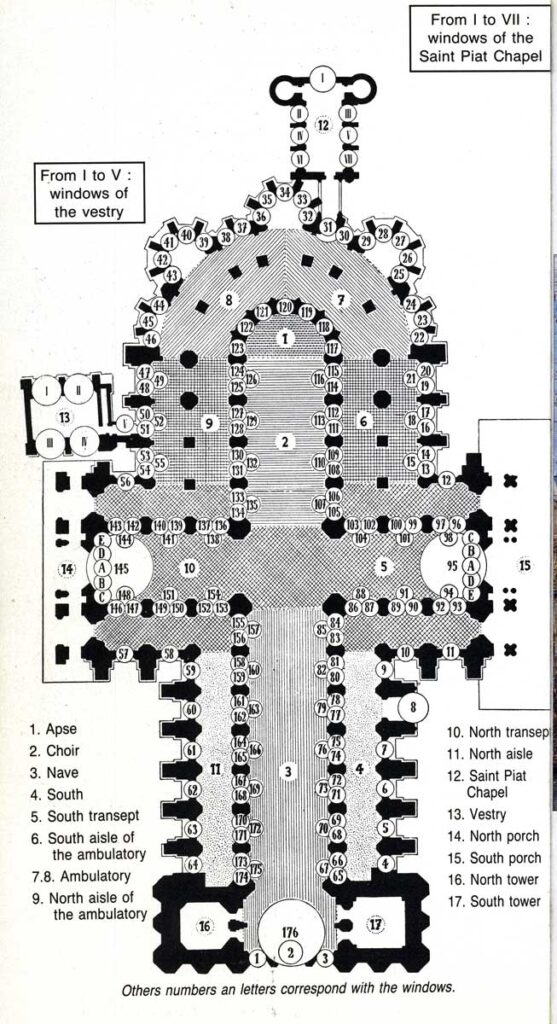
12th century windows
The 12th-century windows in Chartres Cathedral include some of its most significant stained glass works:
Lancet Windows Under West Rose Window: These three windows date back to around 1145 and were later restored.
– The right window, the Jesse Window, displays the genealogy of Christ.
– The central window portrays the life of Christ.
– The left window illustrates the Passion of Christ, covering events from the Transfiguration to the Resurrection.
Notre-Dame de la Belle-Verrière Window: This renowned window, situated in the choir, is a composite.
– The upper part, from around 1180, features the Virgin and Child in a “Throne of Wisdom” composition, surrounded by angels.
– The lower part, added in 1225, depicts scenes from Christ’s infancy.
These windows are among the oldest in the cathedral, showcasing exquisite craftsmanship and vivid storytelling through glass.
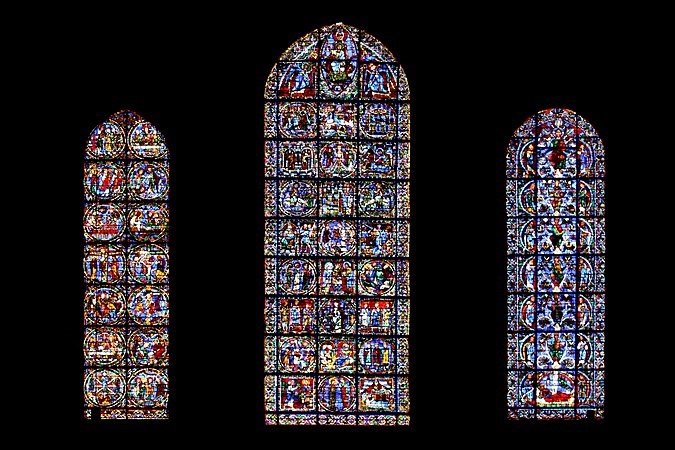
Rose windows
The three large rose windows of Chartres Cathedral are masterpieces of Gothic stained glass art:
West Rose Window (c. 1215): 12 meters in diameter, it depicts the Last Judgment. Christ as Judge is in the central oculus, surrounded by angels, the Elders of the Apocalypse, and scenes of resurrection and judgment.
North Transept Rose Window (c. 1235): Dedicated to the Virgin, it features the Virgin and Child in the central oculus, surrounded by doves, angels, Kings of Judah, and symbols of French royal patronage. Beneath it are lancets depicting Old Testament figures triumphing over their enemies.
South Transept Rose Window (c. 1221–1230): Dedicated to Christ, showing him in benediction surrounded by the 24 Elders of the Apocalypse. The central lancet beneath displays the Virgin with Christ, flanked by the evangelists on the shoulders of prophets, symbolizing the New Testament building upon the Old.
Windows in aisles and the choir ambulatory
The windows in the aisles and choir ambulatory of Chartres Cathedral are remarkable for their themes and depictions:
- Lancet Windows: Each bay has a large window, about 8.1 meters high and 2.2 meters wide, made between 1205 and 1235.
- Themes and Subjects: These windows showcase stories from the Old and New Testament, lives of saints, typological cycles, and symbolic images like zodiac signs and labors of the months.
- Depiction of Local Tradesmen: Notable is the inclusion of local laborers in the lower panels of several windows, such as in the Good Samaritan window. While once thought to represent guild donors, this view is now seen as unlikely due to the high cost of window production and the fact that many depicted tradesmen were subsistence workers.
- Interpretation: The presence of these figures might symbolize the Church’s universal reach and its connection to the local community during a time of complex relations.
Clerestory windows
The clerestory windows of Chartres Cathedral are designed with simplicity and boldness, considering their greater distance from viewers:
Design: These windows usually feature a standing figure of a saint or Apostle in the upper part, with one or two narrative scenes below that either identify the figure or highlight a significant event in their life.
Structure: Unlike the single lancet windows in the lower nave arcades and ambulatory, the clerestory windows consist of paired lancets topped with a plate-traceried rose window.
Themes: The nave and transept clerestory windows mainly depict saints and Old Testament prophets. In the choir, they portray the kings of France and Castile, local nobility, and Old Testament prophets who predicted the virgin birth, with the axial window displaying scenes of the Annunciation, Visitation, and Nativity.
Later windows
The later history of Chartres Cathedral’s windows reflects both preservation and change:
- Fortunate Survival: The medieval glass largely survived the Huguenot iconoclasm and religious wars of the 16th century, though the west rose was damaged in 1591.
- Lighting Changes: To increase interior light, some windows were replaced with lighter grisaille glass in the 14th century, and clear glass in 1753.
- Vendôme Chapel Window: Added in the early 15th century, this window features donor portraits of Louis de Bourbon and his family.
- Preservation Efforts: Industrial Revolution effects prompted restoration in the 19th century. WWII led to the removal and storage of windows for protection, with post-war reinstallation and ongoing conservation, including the addition of isothermal secondary glazing.
restore and preserve the cathedral of Notre-Dame de Chartres
Your contributions are tax deductible in the United States to the extent allowed by law.

